Sushi Yamamoto (Beverly Hills, CA)
Sushi Yamamoto
218 N Rodeo Dr, Beverly Hills, CA 90210
424-204-9584
www.sushiyamamoto-beverlyhills.com
Sat 03/15/2025, 05:30p-07:30p

Old school readers will know that I was a fan of Urasawa back in the day, so I was certainly saddened when the restaurant shuttered in 2020, before I could even sample one of Hiro-san's pandemic-era bentos. Following the closure, I couldn't help but wonder who would be taking over the storied space on the second floor of the Two Rodeo development. Well, I actually found out in December 2021, when I dined at Sushi Kisen. I was told that owner Yamato Miura (Tonchinkan et al.) would be taking over the spot and opening a new concept there, in partnership with a familiar face, Steve Tieu (the SGV insurance guy). I kept things on the down-low during that time, but in 2023, it was finally announced that Sushi Yamamoto (鮨やまもと) would be opening, with Chef Yusuke Yamamoto at the helm.
About the Chef: Yamamoto Yusuke (山本悠介) was born in May 1985 and hails from Shizuoka. Following high school graduation in 2003, he began training at Chiyoda Yoshino Sushi (千代田吉野鮨), where he stayed for four years. From there, he moved to Tokyo and started working at Nobu, then, in June 2014, relocated to Los Angeles for a job at Matsuhisa. However, Yamamoto decamped in July 2019 to start his own company: Moon Meadow, focused on health-conscious Japanese cuisine. During this period, he dabbled in various projects, including vegan bentos boxes, plant-based koji burgers, and even a probiotic teriyaki sauce (sold at Erewhon, of course). The venture eventually fizzled out, and in January 2021, he decided to become a personal sushi chef, though he was still selling bentos at this point. January 2022 saw the birth of daughter Hana (followed by son Haruto last December), and in March 2023, the Chef opened the incarnation of Sushi Yamamoto that we see today, at least on an invitation-only basis (access for the public started on May 2nd).
Meanwhile, running the front-of-the-house is Manager/Sommelier Teppe Fujmura (藤村哲平, or Fujimura Teppei), who's been involved since the beginning. He actually also comes from Shizuoka, and in fact, he and Chef Yamamoto were actually high school friends. Prior to joining the team here, he reportedly honed his service skills at sundry three-star restaurants and hotels such as the Ritz-Carlton.
.jpg)
Inside, things really haven't changed much from the Urasawa days, save for some new decor items. Shown above is the view from my seat at the leftmost position of the L-shaped sushi bar. There's room for six at the earlier seating and eight at the later one, which is actually down from the maximum of 10 back in the Urasawa days.
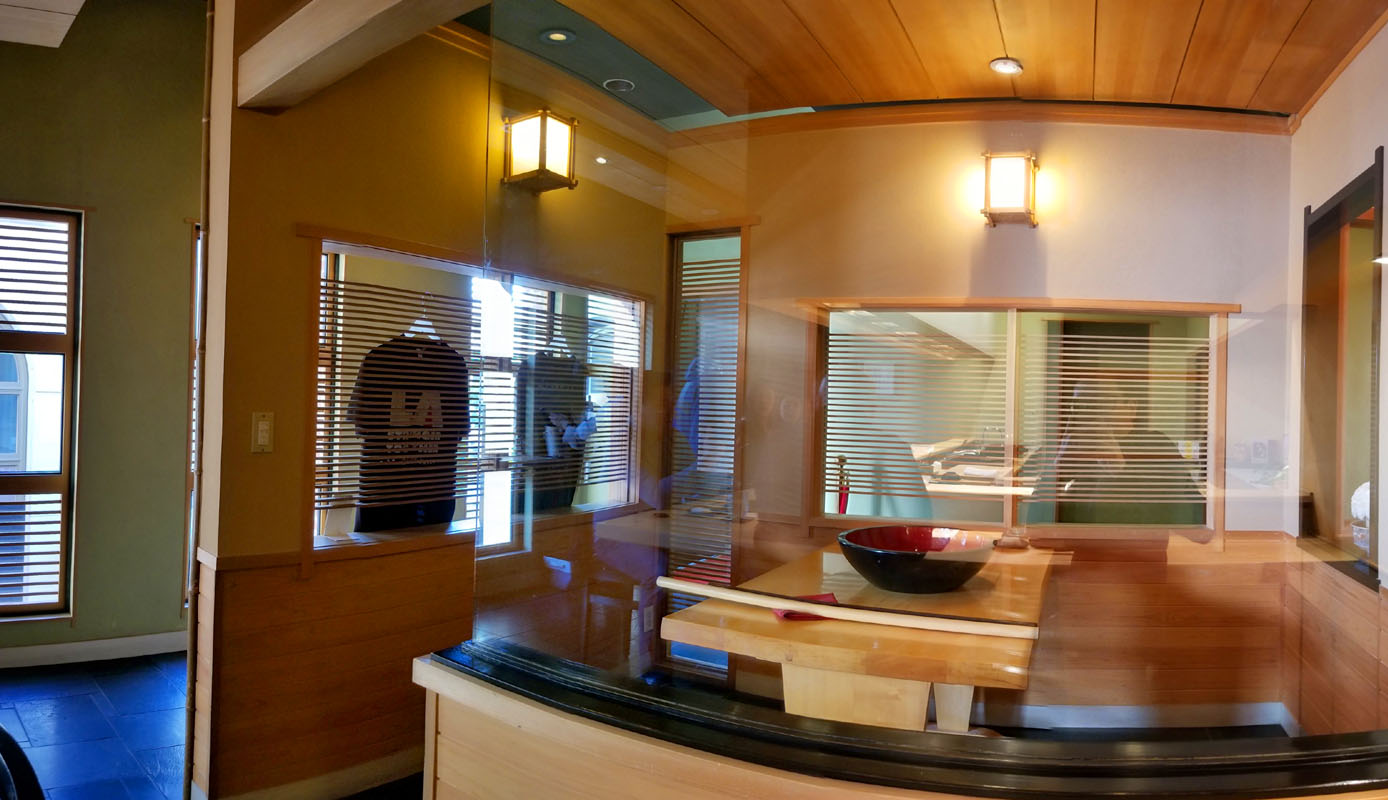
Currently, the semi-private dining room isn't being used to serve customers. Rather, the space is utilized for making soba noodles.
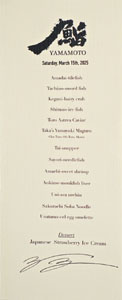
Pictured here is tonight's menu, which was priced at $420 per person (up from $390pp when the place first opened). The inclusion of a printed menu is a welcomed touch that I wish more sushi-ya would implement. Click for a larger version.
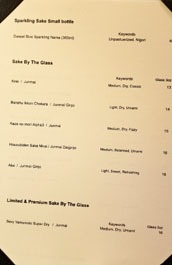
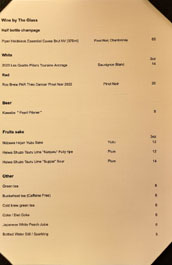
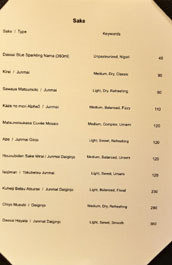

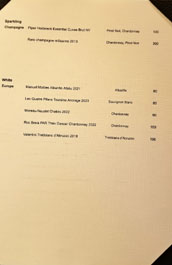
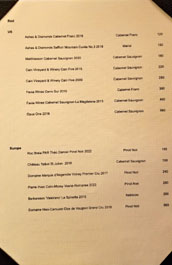
Here we see Sushi Yamamoto's wine list and, more interestingly, selection of sake, which includes some high-end, limited-release bottlings. Do note that the restaurant used to offer a beverage pairing, but that option appears to be off the table now. The corkage fee is $100 a bottle, limit four, rising to $150 a pop after that. Click for larger versions.
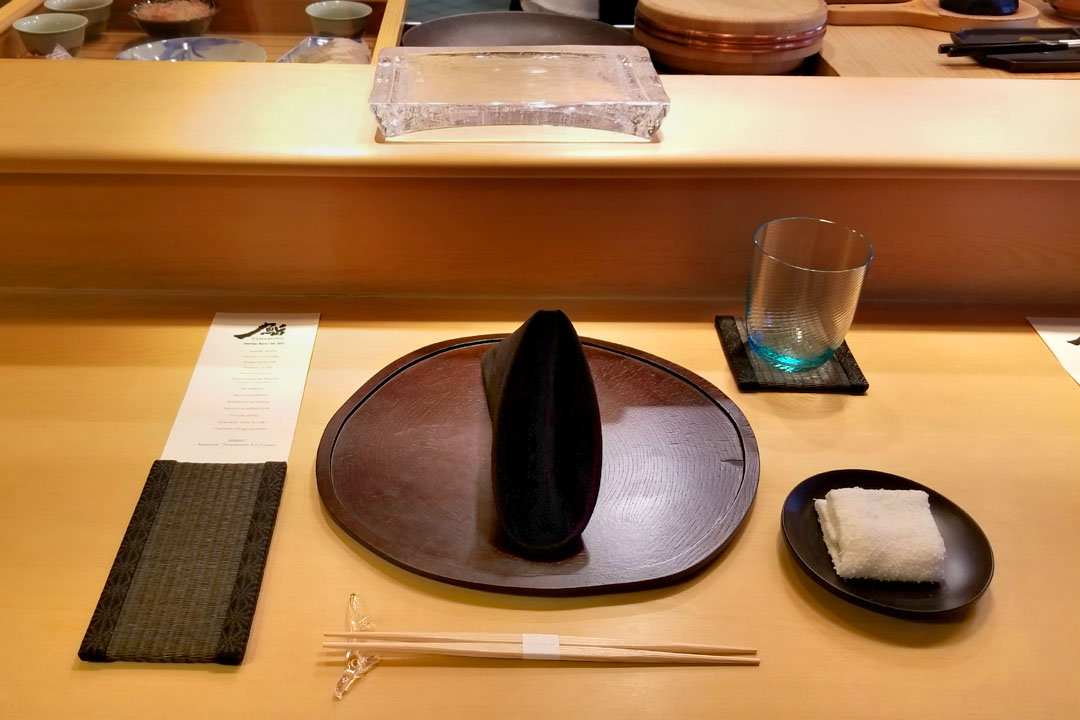
The place setting, replete with oshibori and a phone "coaster."
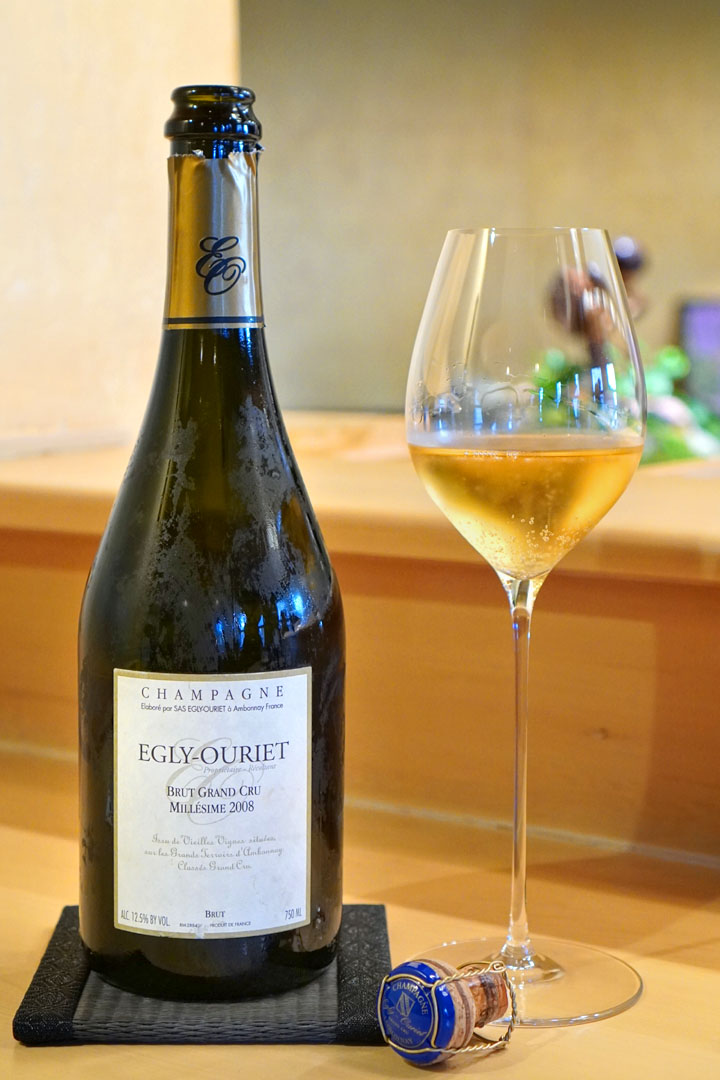
To drink, we BYOB'd three bottles, and first up was the 2008 Egly-Ouriet Champagne Brut Grand Cru Millésime. Its bouquet was ultra concentrated and redolent of stone fruit preserves and brioche, which is pretty much exactly what I want in my bubbly. On the palate, the wine demonstrated boatloads of sweet, juicy apples layered over elements of hazelnut, chalk, and saline. With some time, the aroma displayed more overt apple along with more of those nutty notes, while taste-wise, think jam on toast. My final glass showcased more funkiness on the nose, while the palate was just as bright, luscious, and super vivacious, with tons of ripe, semi-bruised orchard fruit. Overall, this was the tastiest Champ I've had in a while--a tremendous effort possessing both power and grace, with many years still ahead of it.

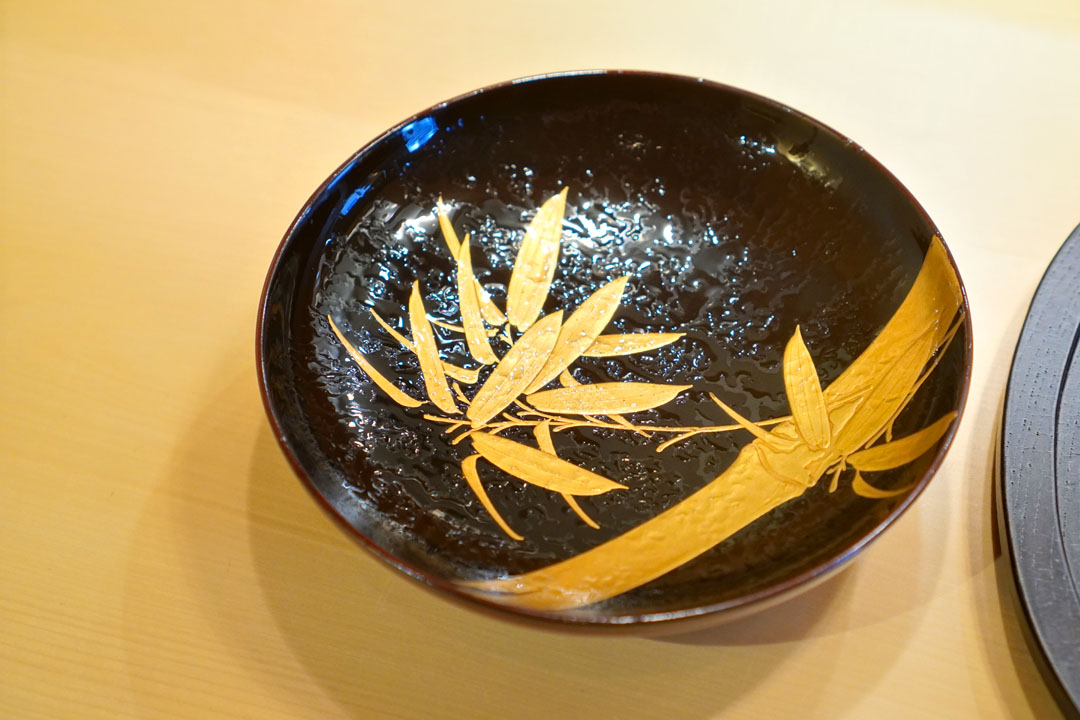
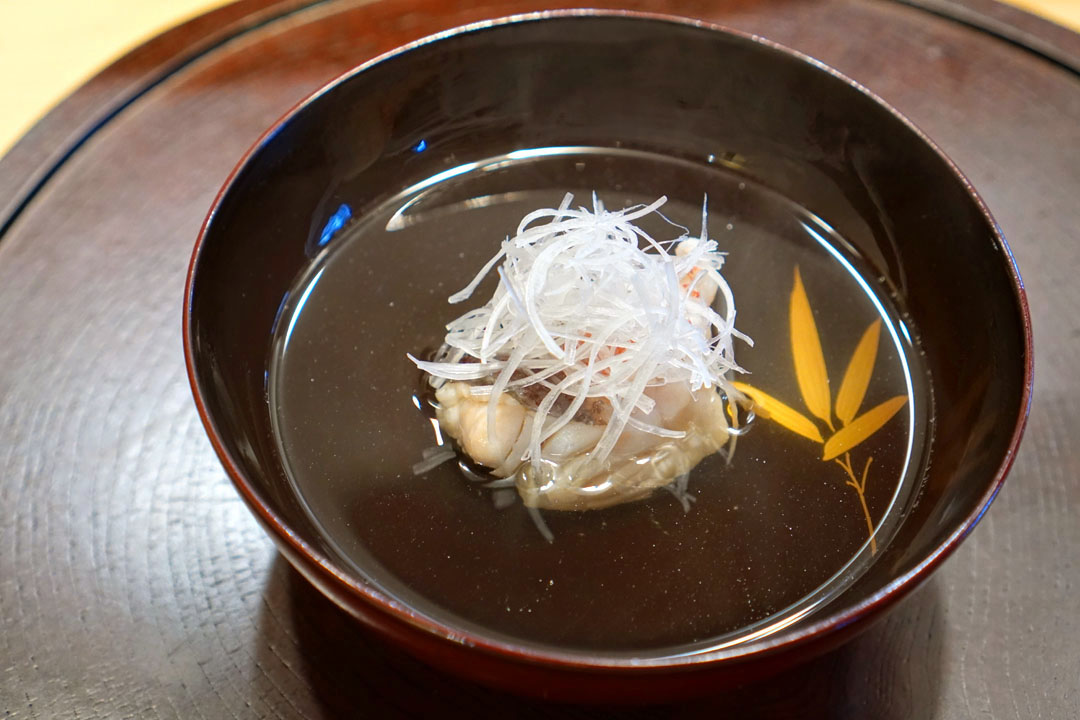
1: Amadai-tilefish
Dinner commenced with a suimono course featuring an expertly cooked cut of Yamaguchi-sourced red tilefish, imbued with a wonderfully cozy, smoky depth along with a restrained salinity and a healthy dose of umami courtesy of a dashi-based broth. Given the flavors at play, the zestiness of those onions on top was absolutely key for balance.
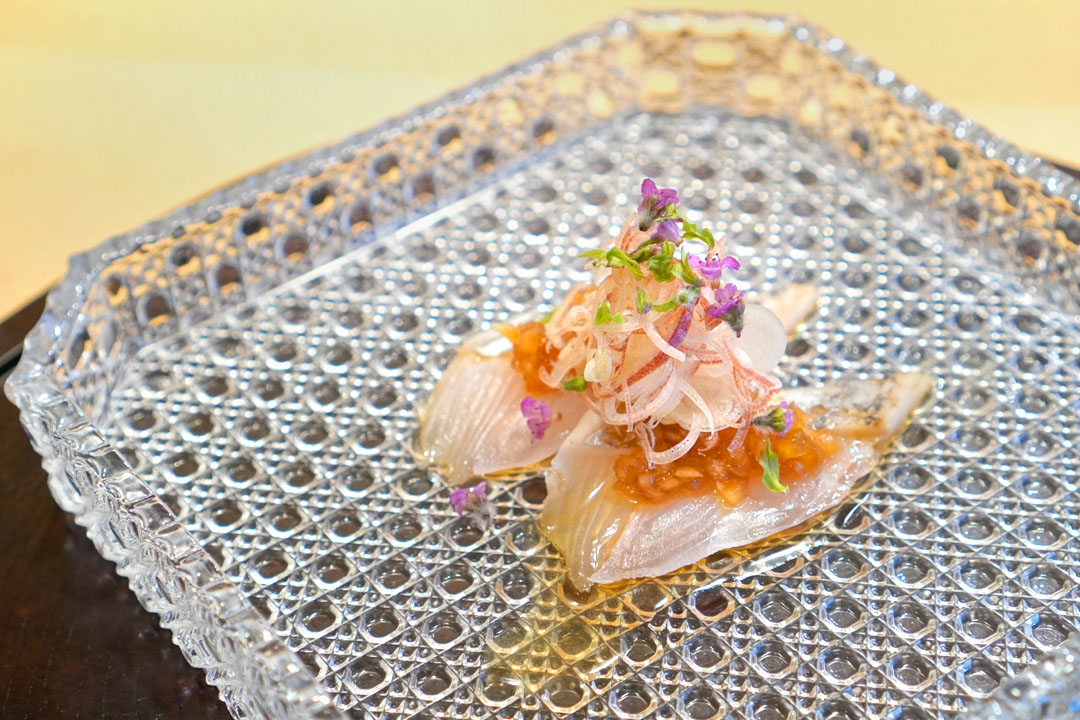
2: Tachiuo-sword fish
Beltfish from Chiba showed off a gratifyingly firm-yet-supple texture, while the fish's clean, lean taste worked hand-in-hand with both the zippy slivers of myoga and the tartness of what I believe was ponzu. I got a nice floral contribution from the shiso flowers, too.

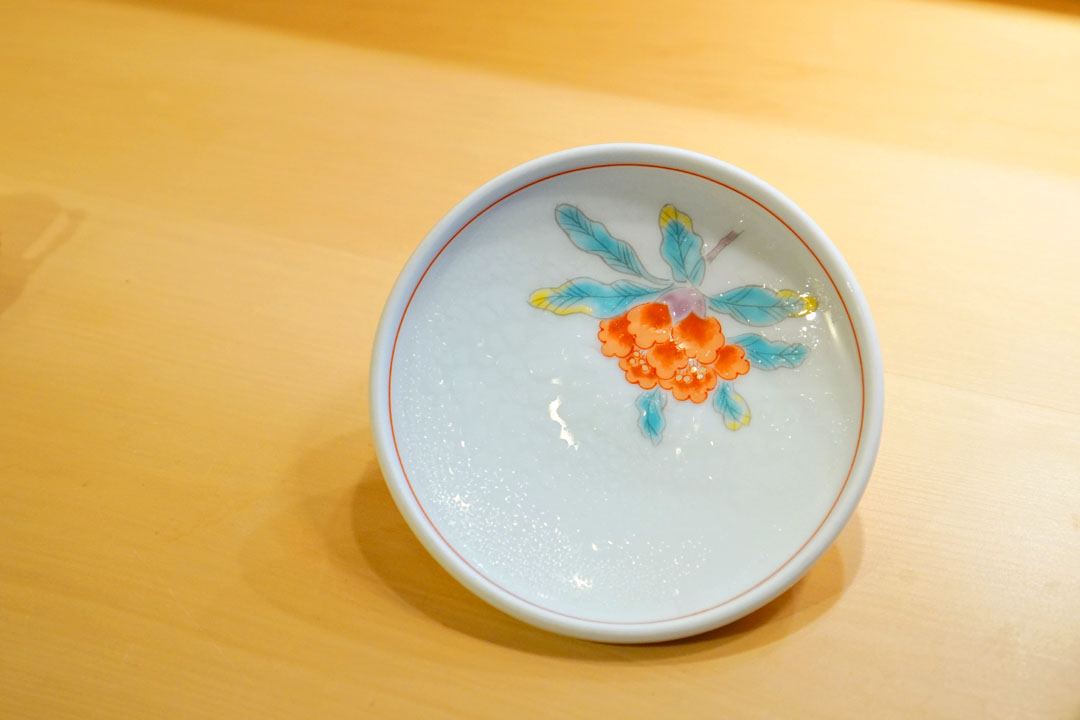
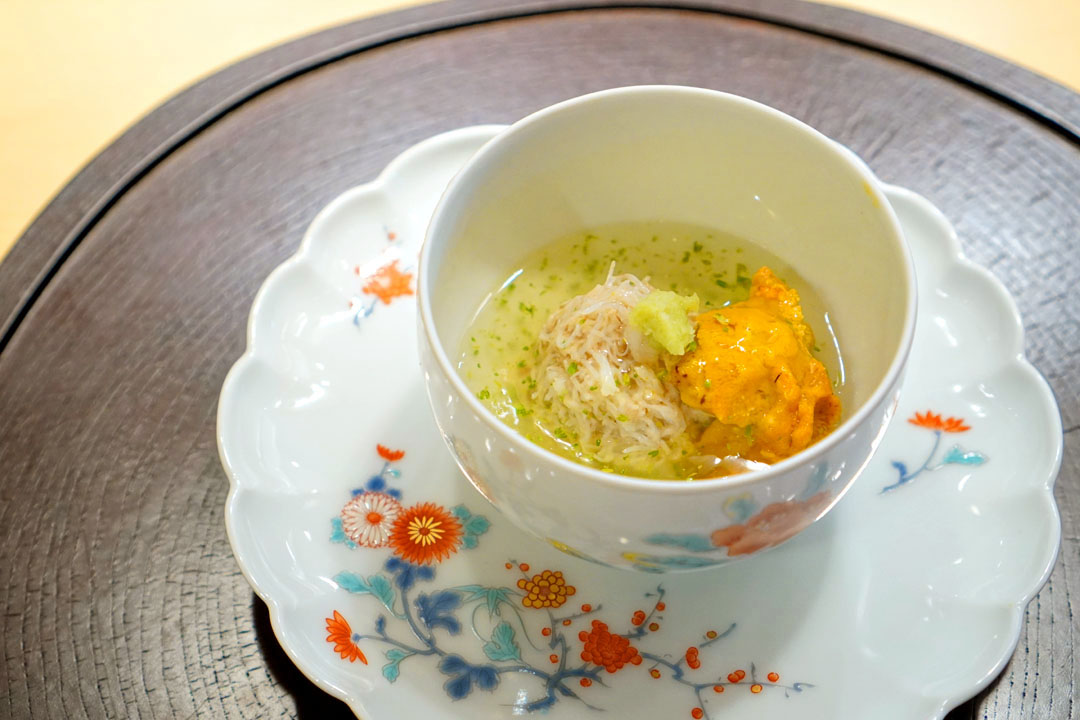
3: Kegani-hairy crab
Here, the gentle sweet-salinity of horsehair crab melded easily with the somewhat more aggressively briny character of bafun sea urchin. It was an effective marriage, especially when combined with the savory-vegetal qualities of the accompanying sauce, a rather viscous concoction that reminded me of ankake. I thoroughly enjoyed the finishing touch provided by the freshly-grated wasabi, too.
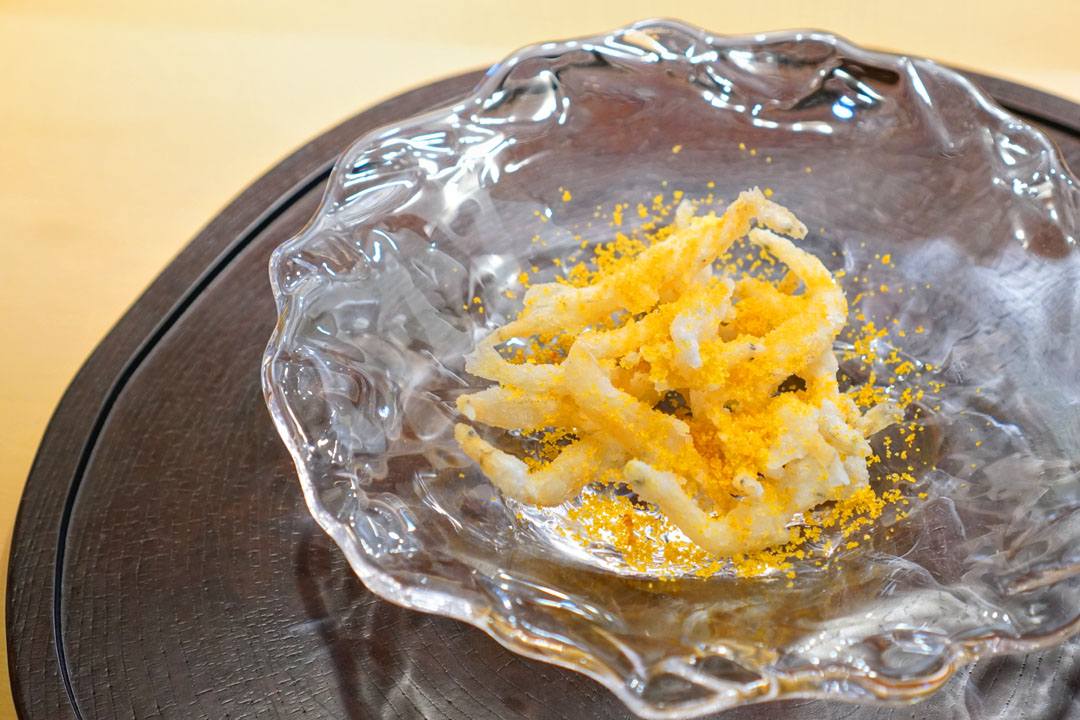
4: Shirauo-ice fish
According to Yamamoto-san, the season for Miyagi icefish just started, so it was nice to see it on the menu tonight. The tiny fish were deep-fried, resulting in lightly crisp exteriors with slightly chewy insides, while their restrained bittersweetness was well-accented by the saltiness of Nagasaki karasumi.
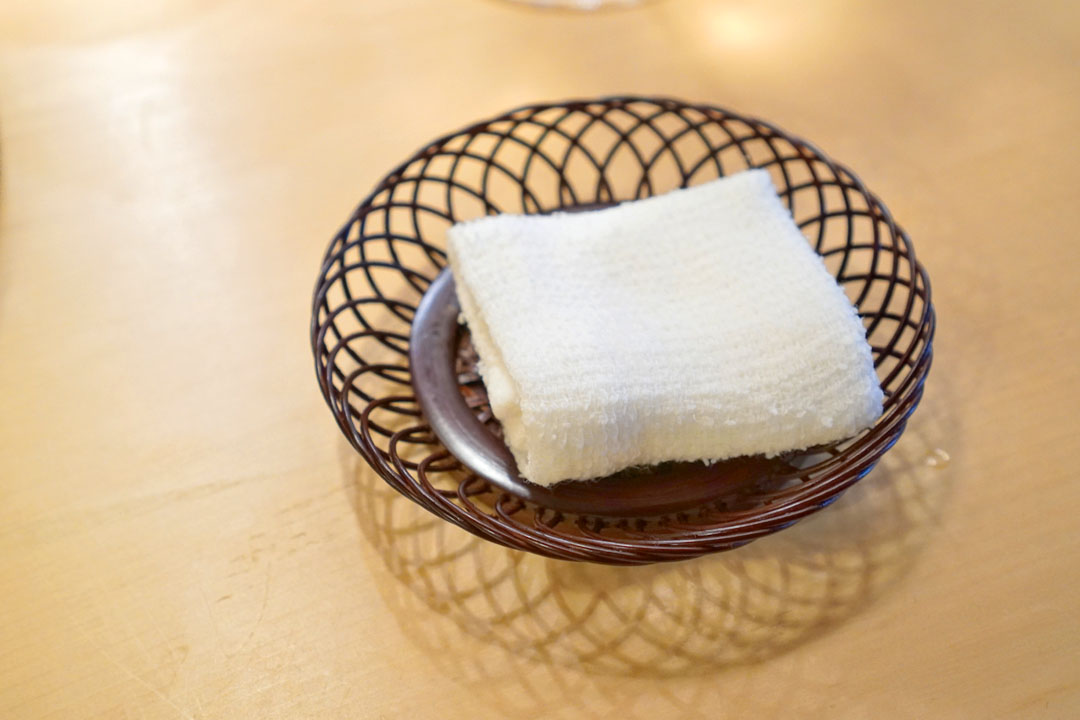
A moistened towel appeared at this point, signaling the start of the "hands-on" portion of our meal.
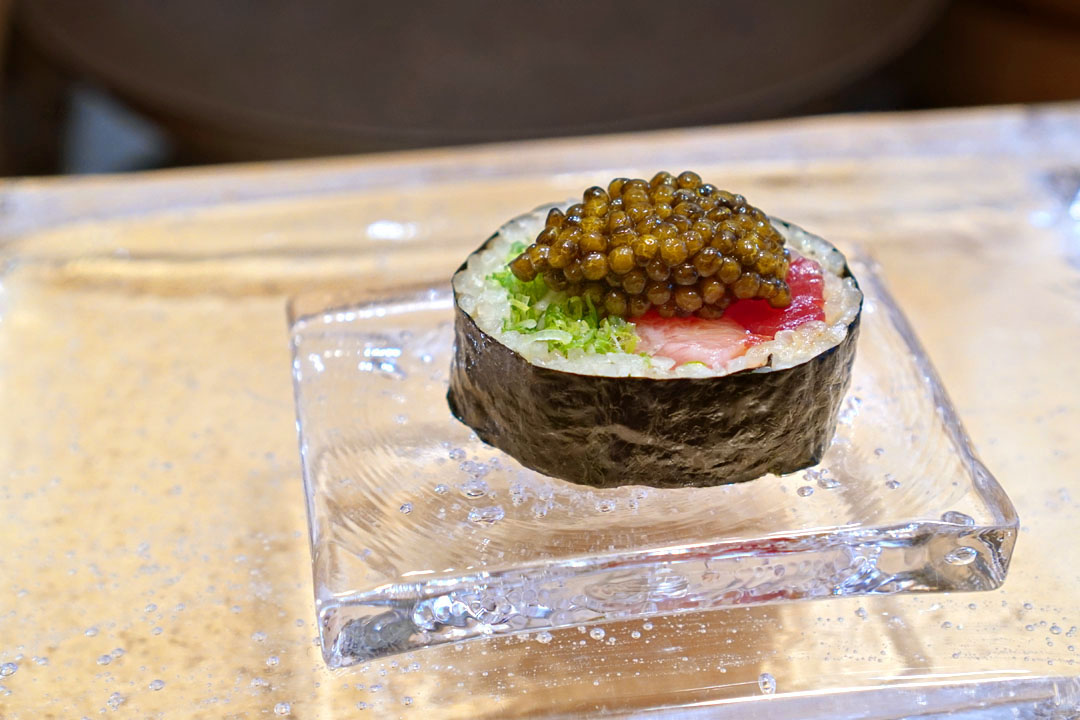
5: Toro Astrea Caviar
Next came what must be the fattest negitoro roll I've ever had. It was also one of the best, thanks to how effectively the pungency of the green onion offset the fatty, umami-laden character of the tuna, all while that Kaluga hybrid caviar amped up the saline factor even further.
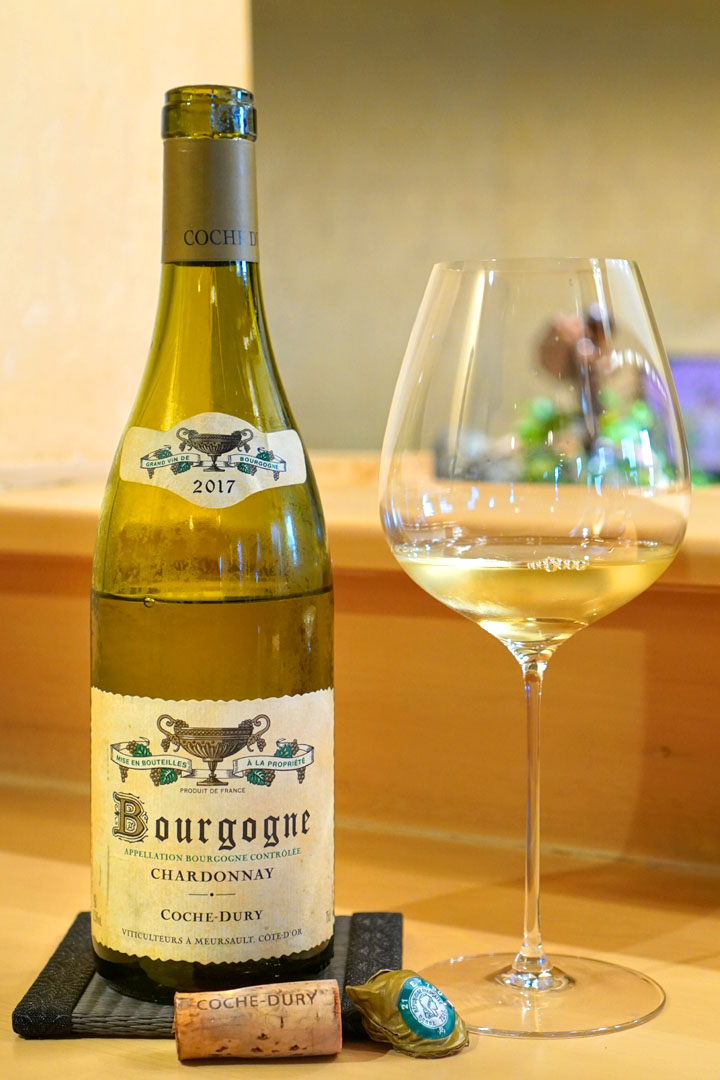
Our second wine was the 2017 Coche-Dury Bourgogne Blanc, which made a very strong showing tonight. Initially, the Burgundy conveyed a delightfully saline bouquet with hints of citrus, while in terms of taste, I found lush yellow fruits backed by a ribbon of brine, with further buttery nuances. With just a bit more time, the palate developed a deliciously juicy, tropical quality that skewed nearly candied. Further evolution brought a distinct nuttiness on the nose, while I began tasting a "green" orchard fruit character alongside more tropicals and florals.
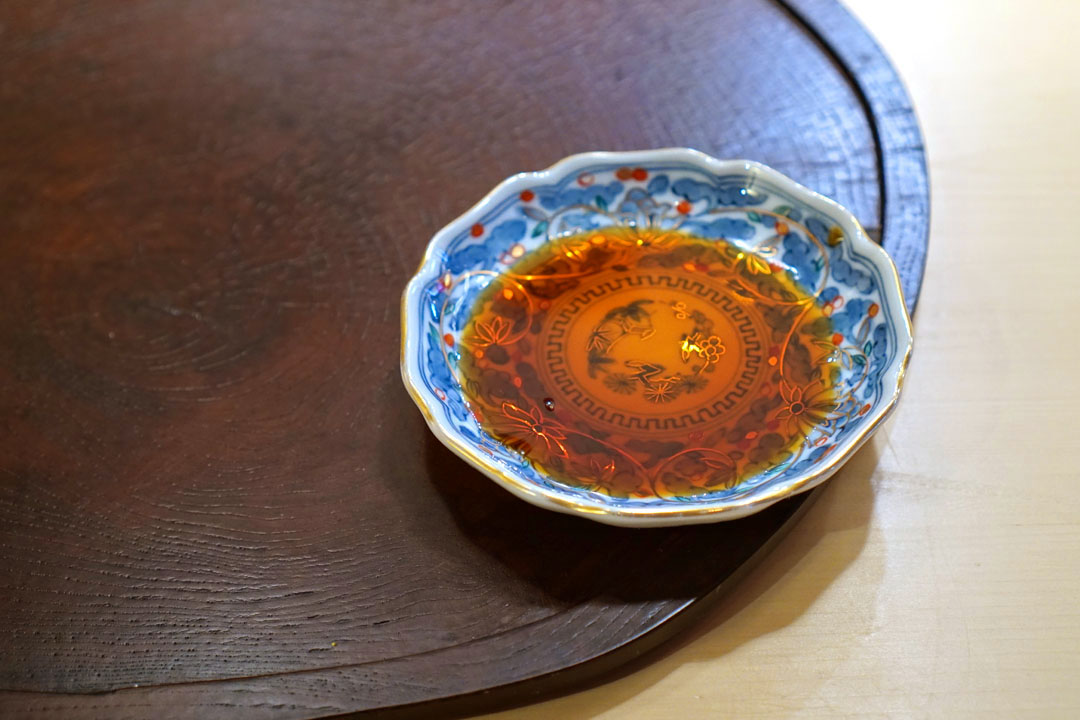
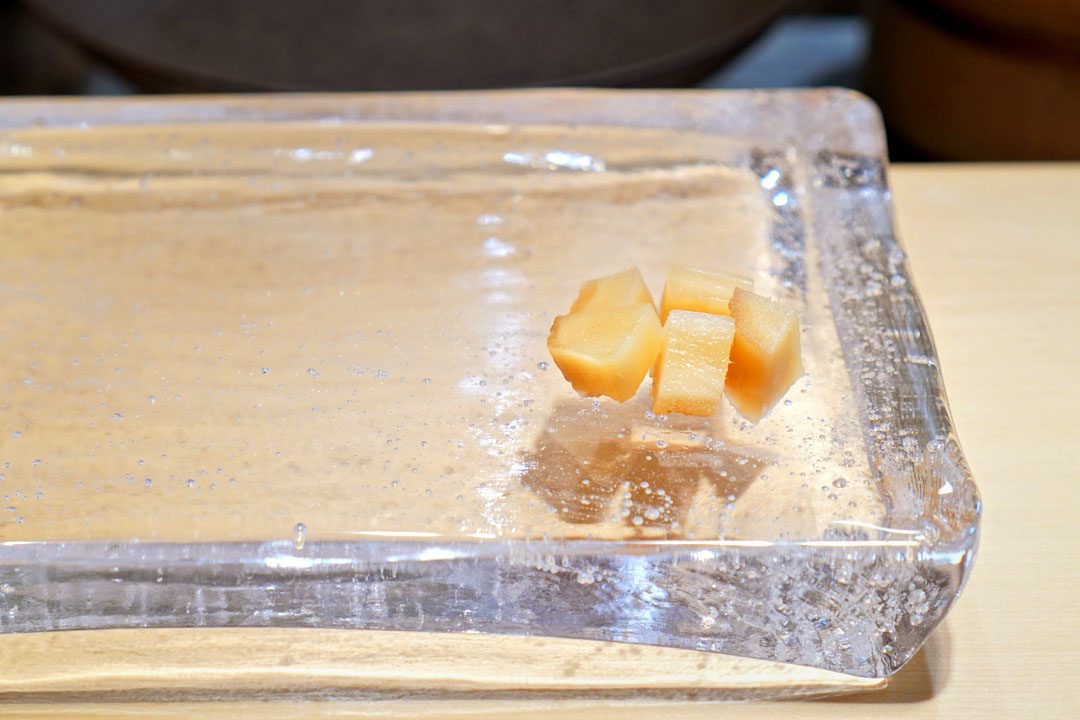
The arrival of soy sauce (unneeded) and ginger (lovely crunch) meant that the nigiri section of dinner was about to commence.
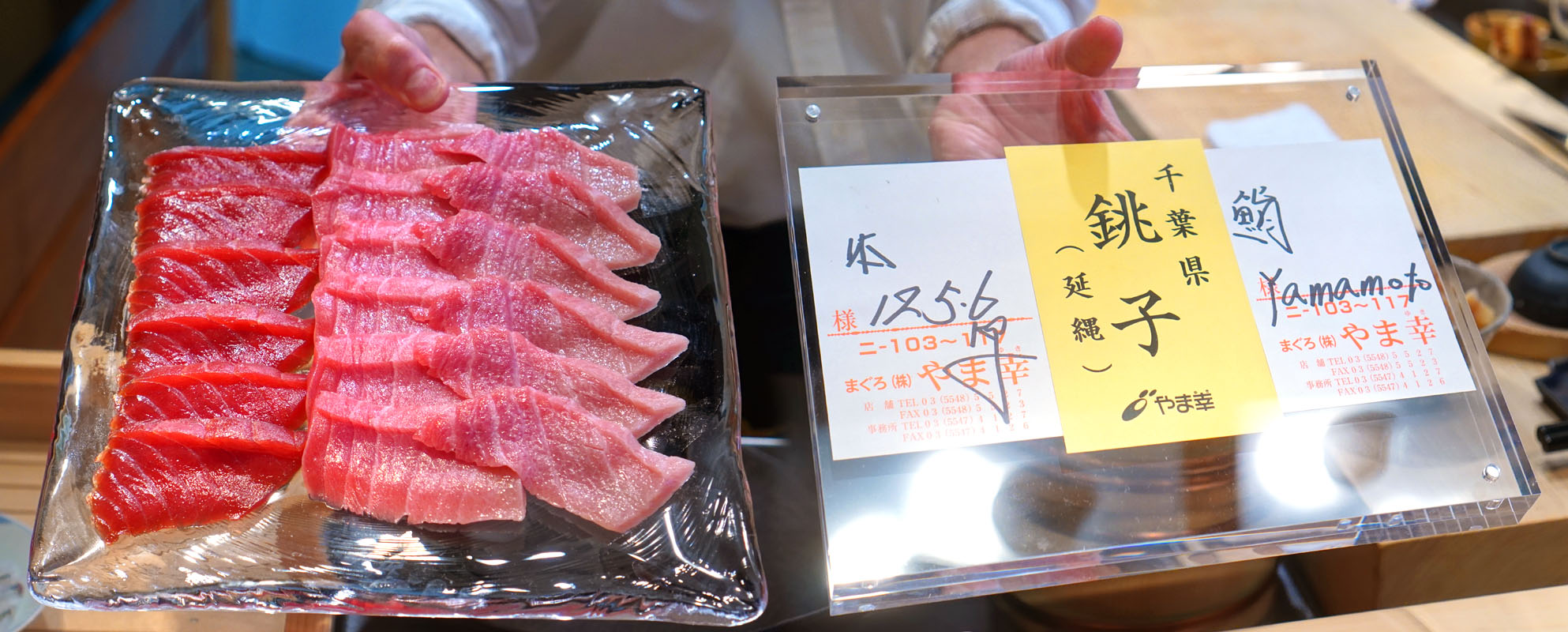
Tonight's longline (延縄) bluefin tuna hailed from Choshi, Chiba Prefecture (銚子, 千葉県), and was sourced from noted Toyosu Market wholesaler Yamayuki (やま幸), helmed by Yukitaka Yamaguchi (山口幸隆).
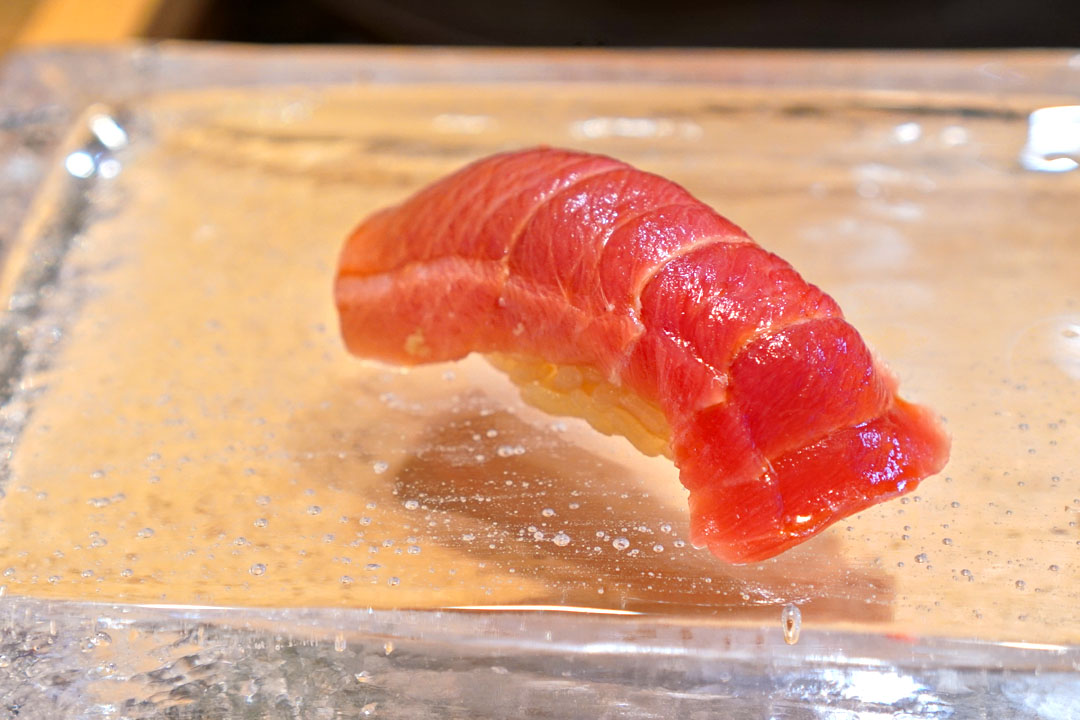
6a: Taka's Yamayuki Maguro | Chu-Toro
Our bluefin threesome began with the chutoro, and I was immediately struck by how "meaty" it was. In addition to its more substantial mouthfeel, the tuna also showcased a heightened level of umami compared to most, while its fattiness was always apparent, but eminently balanced. Of course, also crucial here was the shari, which went in a generally soft, warm, savory, tangy direction and did a superb job playing foil to the fish. This was some of the best chutoro sushi I've had.
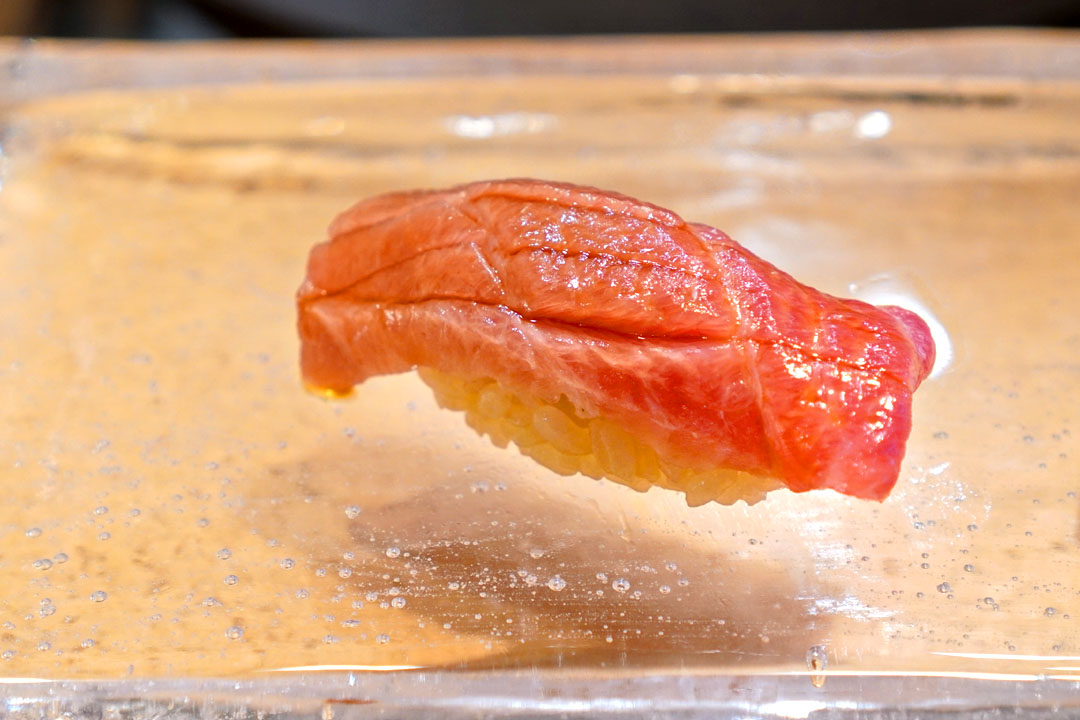
6b: Taka's Yamayuki Maguro | Oh-Toro
The otoro was up next, and it was definitely a big step up in the fattiness, lusciousness, and umami departments. Yet, the tuna never veered overly brash, and made a bunch of sense when taken with the seemingly milder, less vinegary rice utilized.
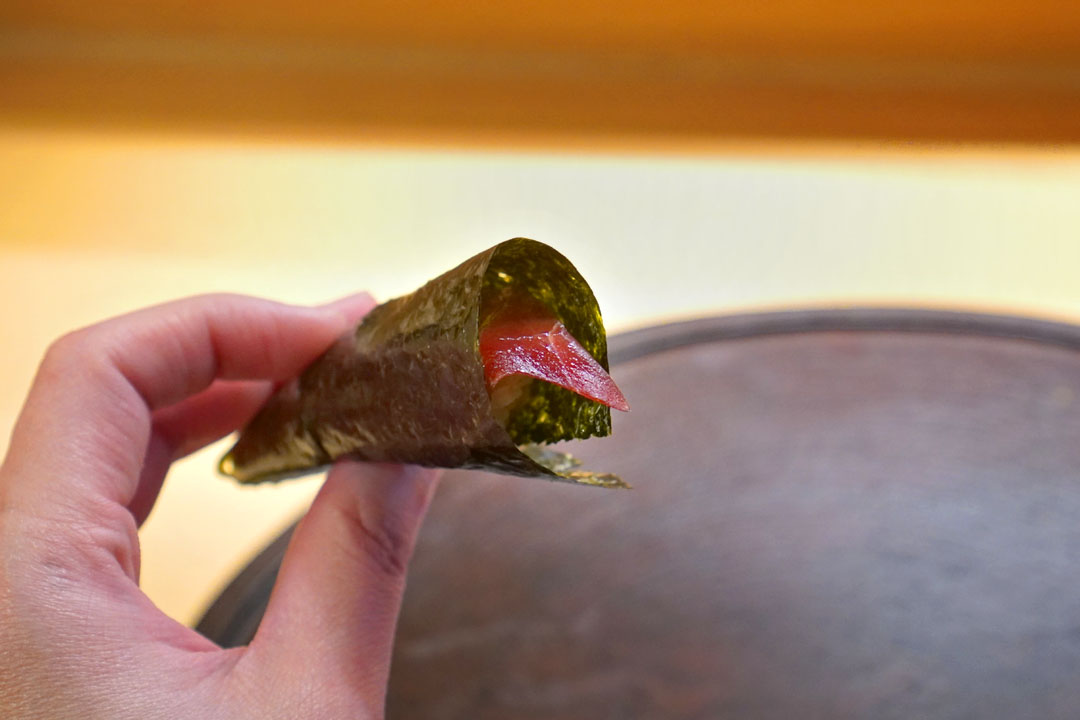
6c: Taka's Yamayuki Maguro | Akami
Last up was the lean meat. I'm not sure why it wasn't presented in nigiri form, but the tuna served its roll duty well, its savoriness meshing swimmingly with expected accompaniments of seaweed and rice.
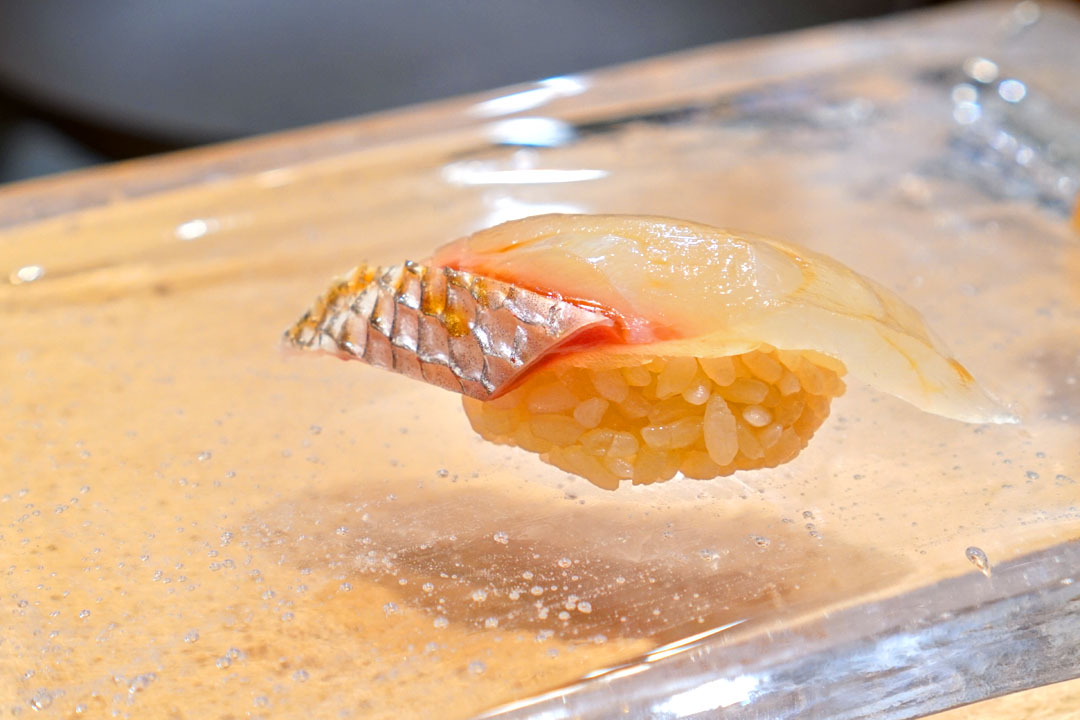
7: Tai-snapper
Madai possessed a firmer-than-usual mouthfeel that I quite enjoyed, while its robust, almost nutty notes were also to my liking. In addition, the rice stood out to me thanks to its more assertive taste and texture.
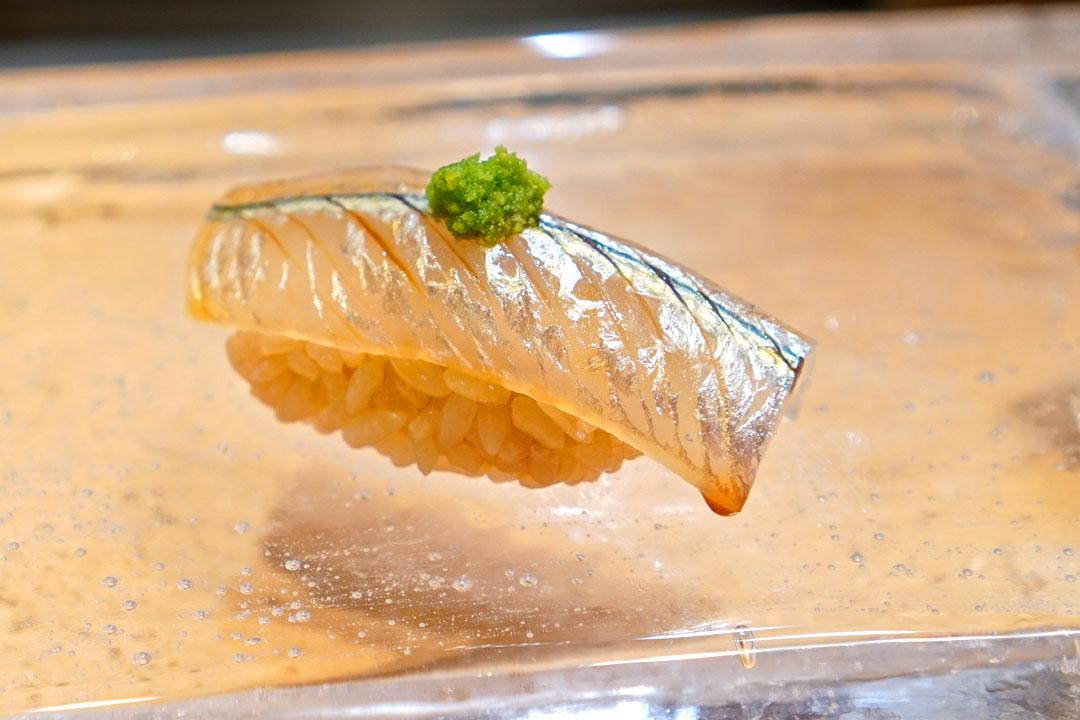
8: Sayori-needlefish
We were at the start of halfbeak season, so it was good to see the neta on the menu this evening. I was a huge fan of the fish's slick texture, and astoundingly, the bite actually reminded me of sour cream and onion dip, while one of my dining companions likened the taste to Chinese-style steamed fish.
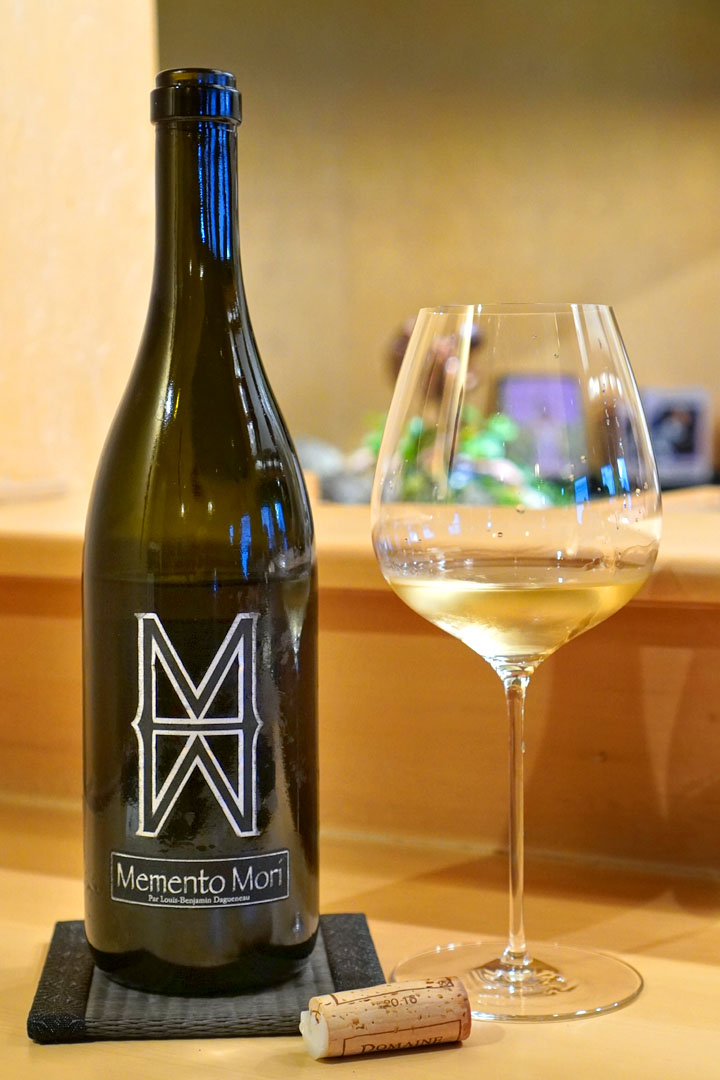
Our final bottle was the 2018 Didier Dagueneau Memento Mori, which was actually the first-ever release of the Sauvignon blanc, produced to honor winemaker's Louis-Benjamin Dagueneau's father. Essentially a higher-end version of Silex, the wine opened with aromas of tropical fruits and florals, but with an underlying astringency that one of my dining companions likened to varnish. On the palate, I found "waxy" white fruits in a crisp, bright, just-acidic-enough package backed by elements of saline. With time, the Vin de France began smelling even more overtly tropical, with that aforementioned varnish-y complexion receding, while taste-wise, I got a stronger mineral component that juxtaposed well with all that lively fruit.
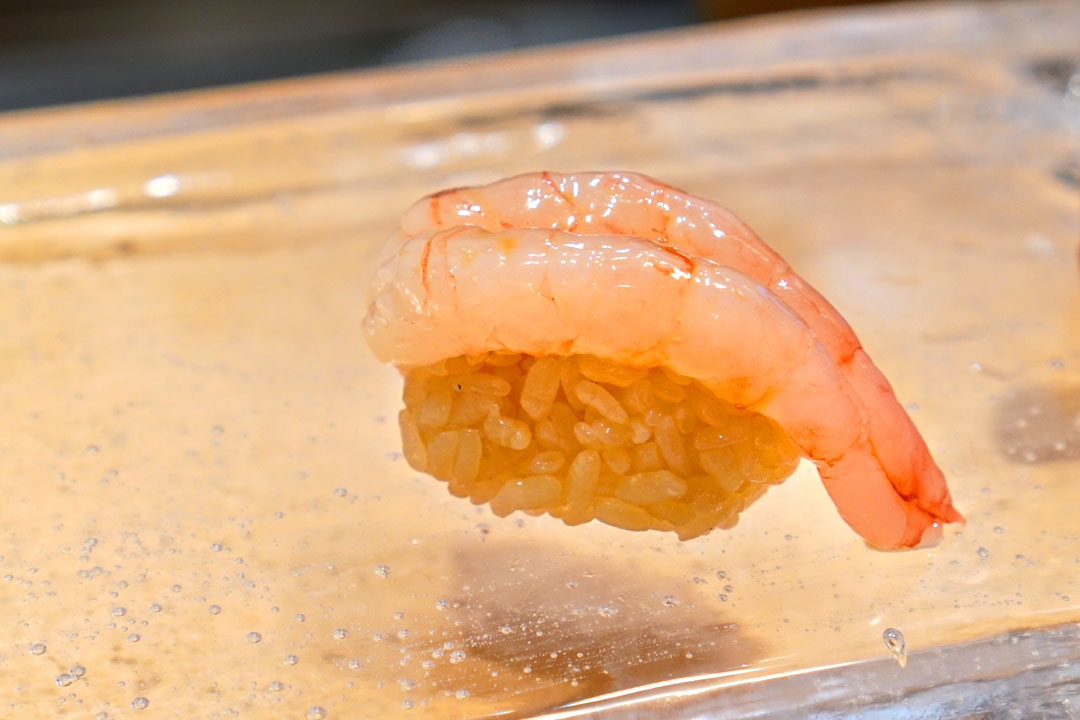
9: Amaebi-sweet shrimp
The sweet shrimp was indeed as sweet as advertised, while its creamy consistency emphasized the somewhat firmer texture of the rice here.
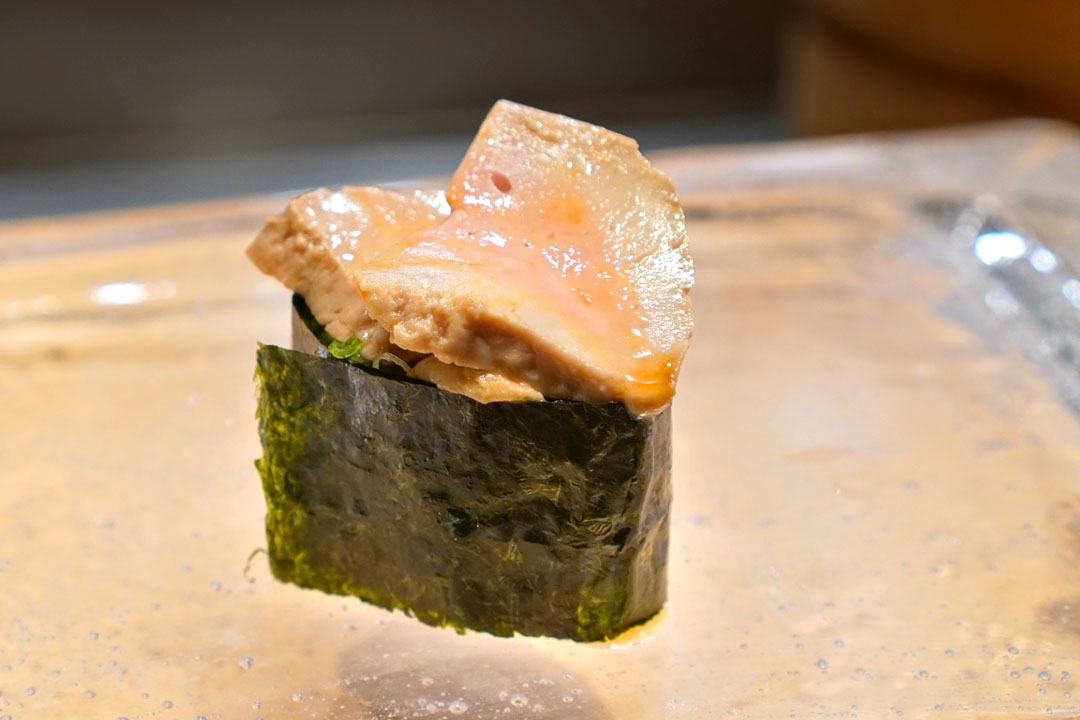
10: Ankimo-monkfish liver
I don't get to enjoy ankimo too often in gunkan-maki form, but it worked out like a dream tonight, with the luxurious liver blending beautifully with the nori and rice, making for a superbly balanced bite overall.
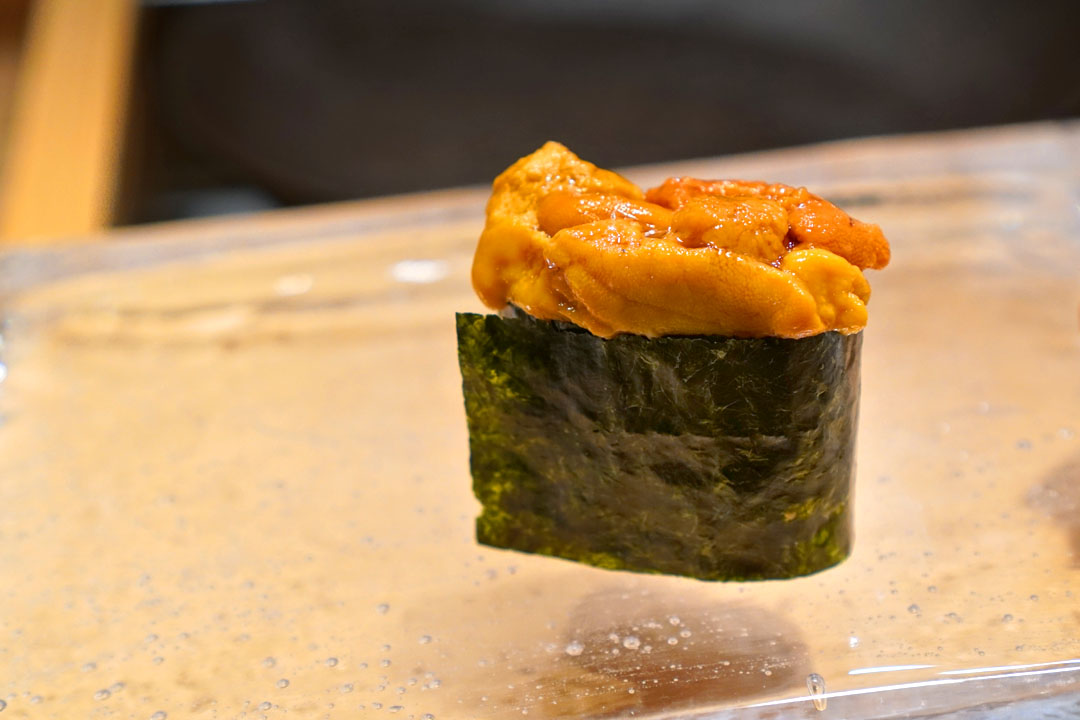
11: Uni-sea urchin
The uni was also pretty much spot-on, the urchin's cool, sweet salinity combining like clockwork with that toasty, grassy nori.
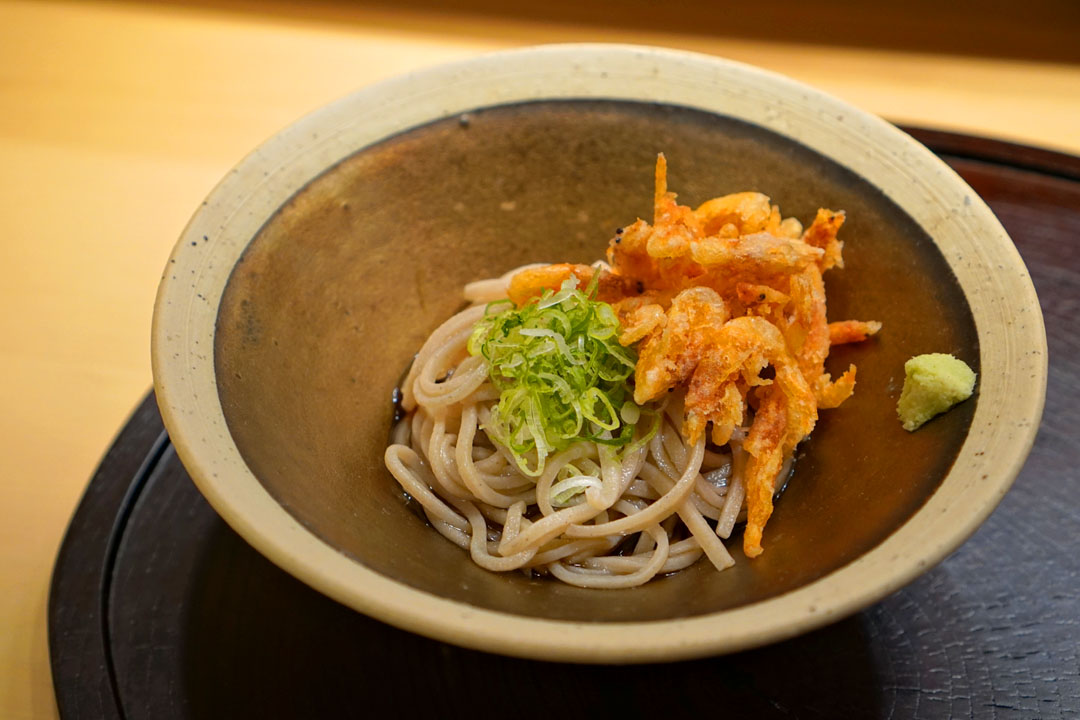
12: Sakuraebi Soba Noodle
Buckwheat noodles were great texturally thanks to their firm-ish mouthfeel and slight chew, while their somewhat nutty flavors contrasted well with the brine of sakura shrimp, all while negi and wasabi lightened the mood.
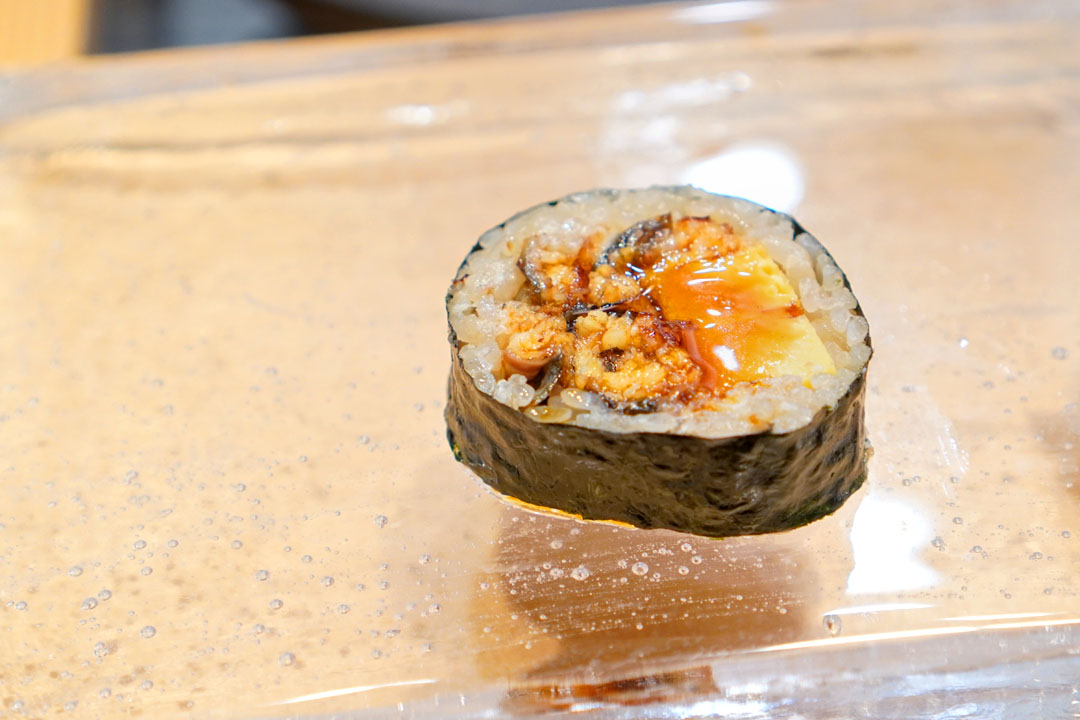
13: Unatama-eel egg omelette
Both unagi and tamago tend to appear at the end of sushi meals, so it was a fun change of pace to enjoy the two traditional closers together, to witness their complementary forces of savory and sweet intertwine.
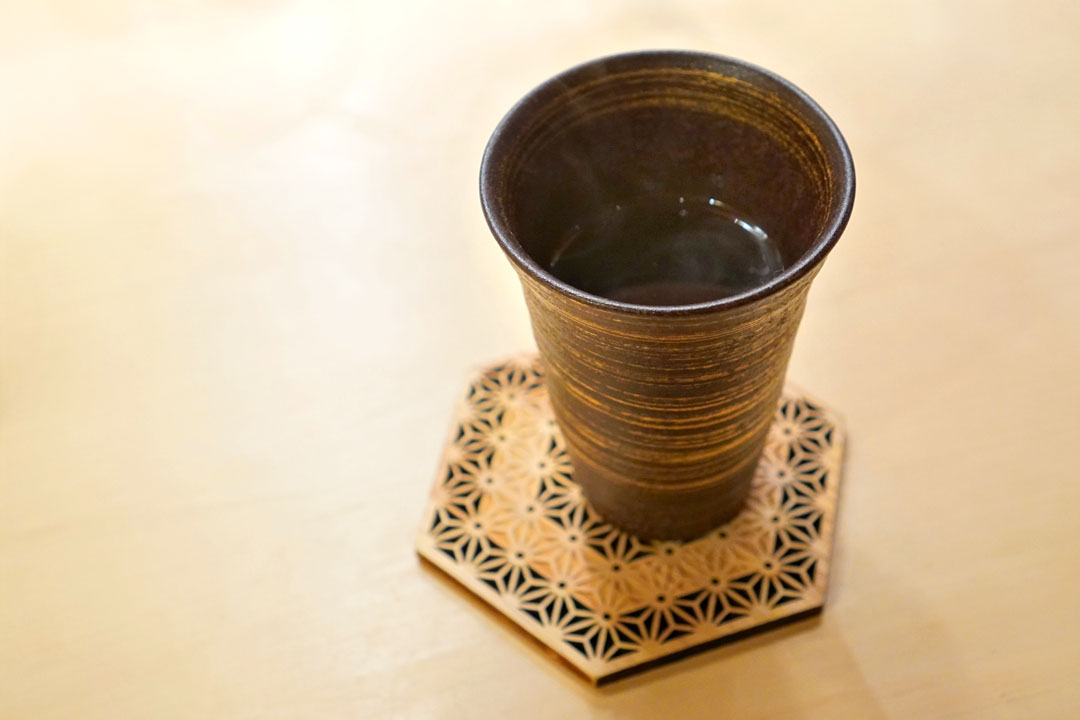
A hot and homey tea to accompany dessert.
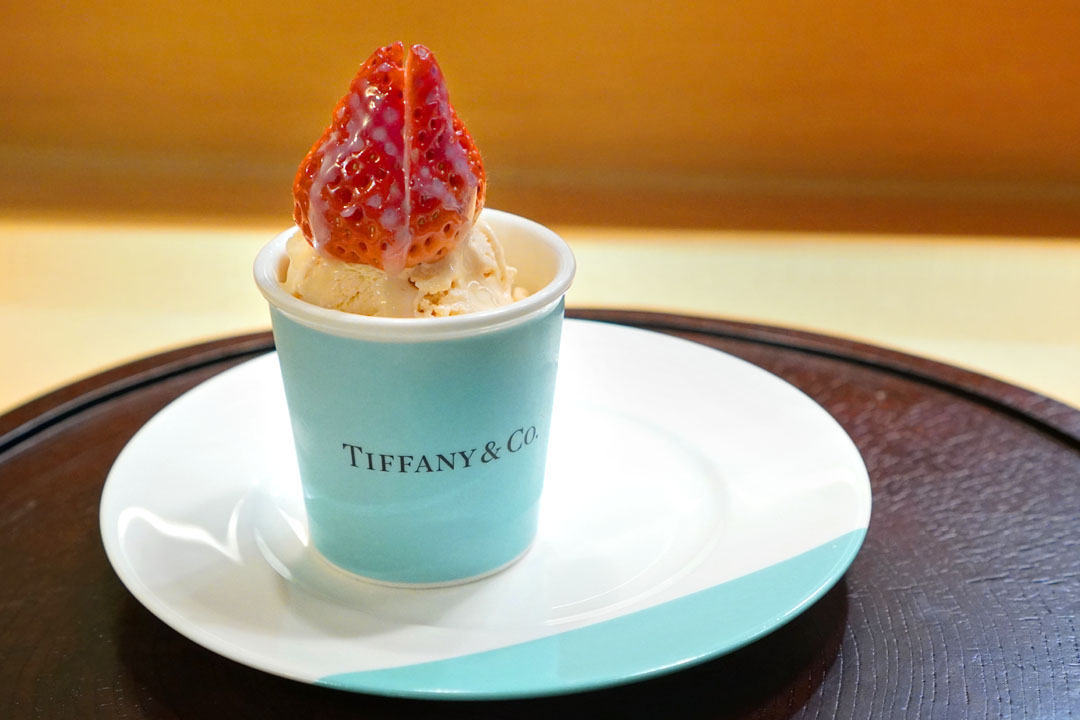
14: Japanese Strawberry Ice Cream
Served in a Tiffany & Co. bone china coffee cup, dessert comprised a homemade ice cream incorporating ichigo from southern Japan. The fruit was quite vibrantly conveyed, and made for a fitting conclusion to our dinner.
I certainly enjoyed the food at Sushi Yamamoto, which at times hearkened back to the luxury and opulence I experienced at Urasawa in decades past. However, my concern was that while what I ate was delicious, there simply wasn't enough of it. My entire party actually stopped for a sausage breakfast burrito and al pastor/carnitas fries on the way back home. Part of the issue may be that the restaurant is trying to squeeze in two seatings a night, so what I'd like to see instead is a single seating, with the menu extended to at least 22 courses.
On a related note, this space previously played host to a kaiseki dinner pop-up on Sundays and Mondays (when Yamamoto's closed) called Kaiseki Motoishi (会席本石). It was run by Kazushige Motoishi (本石一成), who actually assisted Yusuke-san in the kitchen, but the series came to an end of January 6th, before I could try it, sadly. Chef Motoishi has gone back to Japan, but will reportedly return in May to start work on opening a new kaiseki-focused restaurant in Arcadia, once again in partnership with Yamato Miura. I'll definitely be looking forward to that.
In Motoishi's absence, Sundays and Mondays are now the domain of Naoto Tsutsumi, another one of Yamamoto's cooks. He actually comes from the Sushi Enya/Sakurako world, and is offering a lowered priced ($350) sushi omakase alternative, so I might be curious to check that out to see how it compares.
218 N Rodeo Dr, Beverly Hills, CA 90210
424-204-9584
www.sushiyamamoto-beverlyhills.com
Sat 03/15/2025, 05:30p-07:30p

Old school readers will know that I was a fan of Urasawa back in the day, so I was certainly saddened when the restaurant shuttered in 2020, before I could even sample one of Hiro-san's pandemic-era bentos. Following the closure, I couldn't help but wonder who would be taking over the storied space on the second floor of the Two Rodeo development. Well, I actually found out in December 2021, when I dined at Sushi Kisen. I was told that owner Yamato Miura (Tonchinkan et al.) would be taking over the spot and opening a new concept there, in partnership with a familiar face, Steve Tieu (the SGV insurance guy). I kept things on the down-low during that time, but in 2023, it was finally announced that Sushi Yamamoto (鮨やまもと) would be opening, with Chef Yusuke Yamamoto at the helm.
About the Chef: Yamamoto Yusuke (山本悠介) was born in May 1985 and hails from Shizuoka. Following high school graduation in 2003, he began training at Chiyoda Yoshino Sushi (千代田吉野鮨), where he stayed for four years. From there, he moved to Tokyo and started working at Nobu, then, in June 2014, relocated to Los Angeles for a job at Matsuhisa. However, Yamamoto decamped in July 2019 to start his own company: Moon Meadow, focused on health-conscious Japanese cuisine. During this period, he dabbled in various projects, including vegan bentos boxes, plant-based koji burgers, and even a probiotic teriyaki sauce (sold at Erewhon, of course). The venture eventually fizzled out, and in January 2021, he decided to become a personal sushi chef, though he was still selling bentos at this point. January 2022 saw the birth of daughter Hana (followed by son Haruto last December), and in March 2023, the Chef opened the incarnation of Sushi Yamamoto that we see today, at least on an invitation-only basis (access for the public started on May 2nd).
Meanwhile, running the front-of-the-house is Manager/Sommelier Teppe Fujmura (藤村哲平, or Fujimura Teppei), who's been involved since the beginning. He actually also comes from Shizuoka, and in fact, he and Chef Yamamoto were actually high school friends. Prior to joining the team here, he reportedly honed his service skills at sundry three-star restaurants and hotels such as the Ritz-Carlton.
.jpg)
Inside, things really haven't changed much from the Urasawa days, save for some new decor items. Shown above is the view from my seat at the leftmost position of the L-shaped sushi bar. There's room for six at the earlier seating and eight at the later one, which is actually down from the maximum of 10 back in the Urasawa days.

Currently, the semi-private dining room isn't being used to serve customers. Rather, the space is utilized for making soba noodles.

Pictured here is tonight's menu, which was priced at $420 per person (up from $390pp when the place first opened). The inclusion of a printed menu is a welcomed touch that I wish more sushi-ya would implement. Click for a larger version.






Here we see Sushi Yamamoto's wine list and, more interestingly, selection of sake, which includes some high-end, limited-release bottlings. Do note that the restaurant used to offer a beverage pairing, but that option appears to be off the table now. The corkage fee is $100 a bottle, limit four, rising to $150 a pop after that. Click for larger versions.

The place setting, replete with oshibori and a phone "coaster."

To drink, we BYOB'd three bottles, and first up was the 2008 Egly-Ouriet Champagne Brut Grand Cru Millésime. Its bouquet was ultra concentrated and redolent of stone fruit preserves and brioche, which is pretty much exactly what I want in my bubbly. On the palate, the wine demonstrated boatloads of sweet, juicy apples layered over elements of hazelnut, chalk, and saline. With some time, the aroma displayed more overt apple along with more of those nutty notes, while taste-wise, think jam on toast. My final glass showcased more funkiness on the nose, while the palate was just as bright, luscious, and super vivacious, with tons of ripe, semi-bruised orchard fruit. Overall, this was the tastiest Champ I've had in a while--a tremendous effort possessing both power and grace, with many years still ahead of it.



1: Amadai-tilefish
Dinner commenced with a suimono course featuring an expertly cooked cut of Yamaguchi-sourced red tilefish, imbued with a wonderfully cozy, smoky depth along with a restrained salinity and a healthy dose of umami courtesy of a dashi-based broth. Given the flavors at play, the zestiness of those onions on top was absolutely key for balance.

2: Tachiuo-sword fish
Beltfish from Chiba showed off a gratifyingly firm-yet-supple texture, while the fish's clean, lean taste worked hand-in-hand with both the zippy slivers of myoga and the tartness of what I believe was ponzu. I got a nice floral contribution from the shiso flowers, too.



3: Kegani-hairy crab
Here, the gentle sweet-salinity of horsehair crab melded easily with the somewhat more aggressively briny character of bafun sea urchin. It was an effective marriage, especially when combined with the savory-vegetal qualities of the accompanying sauce, a rather viscous concoction that reminded me of ankake. I thoroughly enjoyed the finishing touch provided by the freshly-grated wasabi, too.

4: Shirauo-ice fish
According to Yamamoto-san, the season for Miyagi icefish just started, so it was nice to see it on the menu tonight. The tiny fish were deep-fried, resulting in lightly crisp exteriors with slightly chewy insides, while their restrained bittersweetness was well-accented by the saltiness of Nagasaki karasumi.

A moistened towel appeared at this point, signaling the start of the "hands-on" portion of our meal.

5: Toro Astrea Caviar
Next came what must be the fattest negitoro roll I've ever had. It was also one of the best, thanks to how effectively the pungency of the green onion offset the fatty, umami-laden character of the tuna, all while that Kaluga hybrid caviar amped up the saline factor even further.

Our second wine was the 2017 Coche-Dury Bourgogne Blanc, which made a very strong showing tonight. Initially, the Burgundy conveyed a delightfully saline bouquet with hints of citrus, while in terms of taste, I found lush yellow fruits backed by a ribbon of brine, with further buttery nuances. With just a bit more time, the palate developed a deliciously juicy, tropical quality that skewed nearly candied. Further evolution brought a distinct nuttiness on the nose, while I began tasting a "green" orchard fruit character alongside more tropicals and florals.


The arrival of soy sauce (unneeded) and ginger (lovely crunch) meant that the nigiri section of dinner was about to commence.

Tonight's longline (延縄) bluefin tuna hailed from Choshi, Chiba Prefecture (銚子, 千葉県), and was sourced from noted Toyosu Market wholesaler Yamayuki (やま幸), helmed by Yukitaka Yamaguchi (山口幸隆).

6a: Taka's Yamayuki Maguro | Chu-Toro
Our bluefin threesome began with the chutoro, and I was immediately struck by how "meaty" it was. In addition to its more substantial mouthfeel, the tuna also showcased a heightened level of umami compared to most, while its fattiness was always apparent, but eminently balanced. Of course, also crucial here was the shari, which went in a generally soft, warm, savory, tangy direction and did a superb job playing foil to the fish. This was some of the best chutoro sushi I've had.

6b: Taka's Yamayuki Maguro | Oh-Toro
The otoro was up next, and it was definitely a big step up in the fattiness, lusciousness, and umami departments. Yet, the tuna never veered overly brash, and made a bunch of sense when taken with the seemingly milder, less vinegary rice utilized.

6c: Taka's Yamayuki Maguro | Akami
Last up was the lean meat. I'm not sure why it wasn't presented in nigiri form, but the tuna served its roll duty well, its savoriness meshing swimmingly with expected accompaniments of seaweed and rice.

7: Tai-snapper
Madai possessed a firmer-than-usual mouthfeel that I quite enjoyed, while its robust, almost nutty notes were also to my liking. In addition, the rice stood out to me thanks to its more assertive taste and texture.

8: Sayori-needlefish
We were at the start of halfbeak season, so it was good to see the neta on the menu this evening. I was a huge fan of the fish's slick texture, and astoundingly, the bite actually reminded me of sour cream and onion dip, while one of my dining companions likened the taste to Chinese-style steamed fish.

Our final bottle was the 2018 Didier Dagueneau Memento Mori, which was actually the first-ever release of the Sauvignon blanc, produced to honor winemaker's Louis-Benjamin Dagueneau's father. Essentially a higher-end version of Silex, the wine opened with aromas of tropical fruits and florals, but with an underlying astringency that one of my dining companions likened to varnish. On the palate, I found "waxy" white fruits in a crisp, bright, just-acidic-enough package backed by elements of saline. With time, the Vin de France began smelling even more overtly tropical, with that aforementioned varnish-y complexion receding, while taste-wise, I got a stronger mineral component that juxtaposed well with all that lively fruit.

9: Amaebi-sweet shrimp
The sweet shrimp was indeed as sweet as advertised, while its creamy consistency emphasized the somewhat firmer texture of the rice here.

10: Ankimo-monkfish liver
I don't get to enjoy ankimo too often in gunkan-maki form, but it worked out like a dream tonight, with the luxurious liver blending beautifully with the nori and rice, making for a superbly balanced bite overall.

11: Uni-sea urchin
The uni was also pretty much spot-on, the urchin's cool, sweet salinity combining like clockwork with that toasty, grassy nori.

12: Sakuraebi Soba Noodle
Buckwheat noodles were great texturally thanks to their firm-ish mouthfeel and slight chew, while their somewhat nutty flavors contrasted well with the brine of sakura shrimp, all while negi and wasabi lightened the mood.

13: Unatama-eel egg omelette
Both unagi and tamago tend to appear at the end of sushi meals, so it was a fun change of pace to enjoy the two traditional closers together, to witness their complementary forces of savory and sweet intertwine.

A hot and homey tea to accompany dessert.

14: Japanese Strawberry Ice Cream
Served in a Tiffany & Co. bone china coffee cup, dessert comprised a homemade ice cream incorporating ichigo from southern Japan. The fruit was quite vibrantly conveyed, and made for a fitting conclusion to our dinner.
I certainly enjoyed the food at Sushi Yamamoto, which at times hearkened back to the luxury and opulence I experienced at Urasawa in decades past. However, my concern was that while what I ate was delicious, there simply wasn't enough of it. My entire party actually stopped for a sausage breakfast burrito and al pastor/carnitas fries on the way back home. Part of the issue may be that the restaurant is trying to squeeze in two seatings a night, so what I'd like to see instead is a single seating, with the menu extended to at least 22 courses.
On a related note, this space previously played host to a kaiseki dinner pop-up on Sundays and Mondays (when Yamamoto's closed) called Kaiseki Motoishi (会席本石). It was run by Kazushige Motoishi (本石一成), who actually assisted Yusuke-san in the kitchen, but the series came to an end of January 6th, before I could try it, sadly. Chef Motoishi has gone back to Japan, but will reportedly return in May to start work on opening a new kaiseki-focused restaurant in Arcadia, once again in partnership with Yamato Miura. I'll definitely be looking forward to that.
In Motoishi's absence, Sundays and Mondays are now the domain of Naoto Tsutsumi, another one of Yamamoto's cooks. He actually comes from the Sushi Enya/Sakurako world, and is offering a lowered priced ($350) sushi omakase alternative, so I might be curious to check that out to see how it compares.
0 Comments:
Post a Comment
Subscribe to Post Comments [Atom]
<< Home